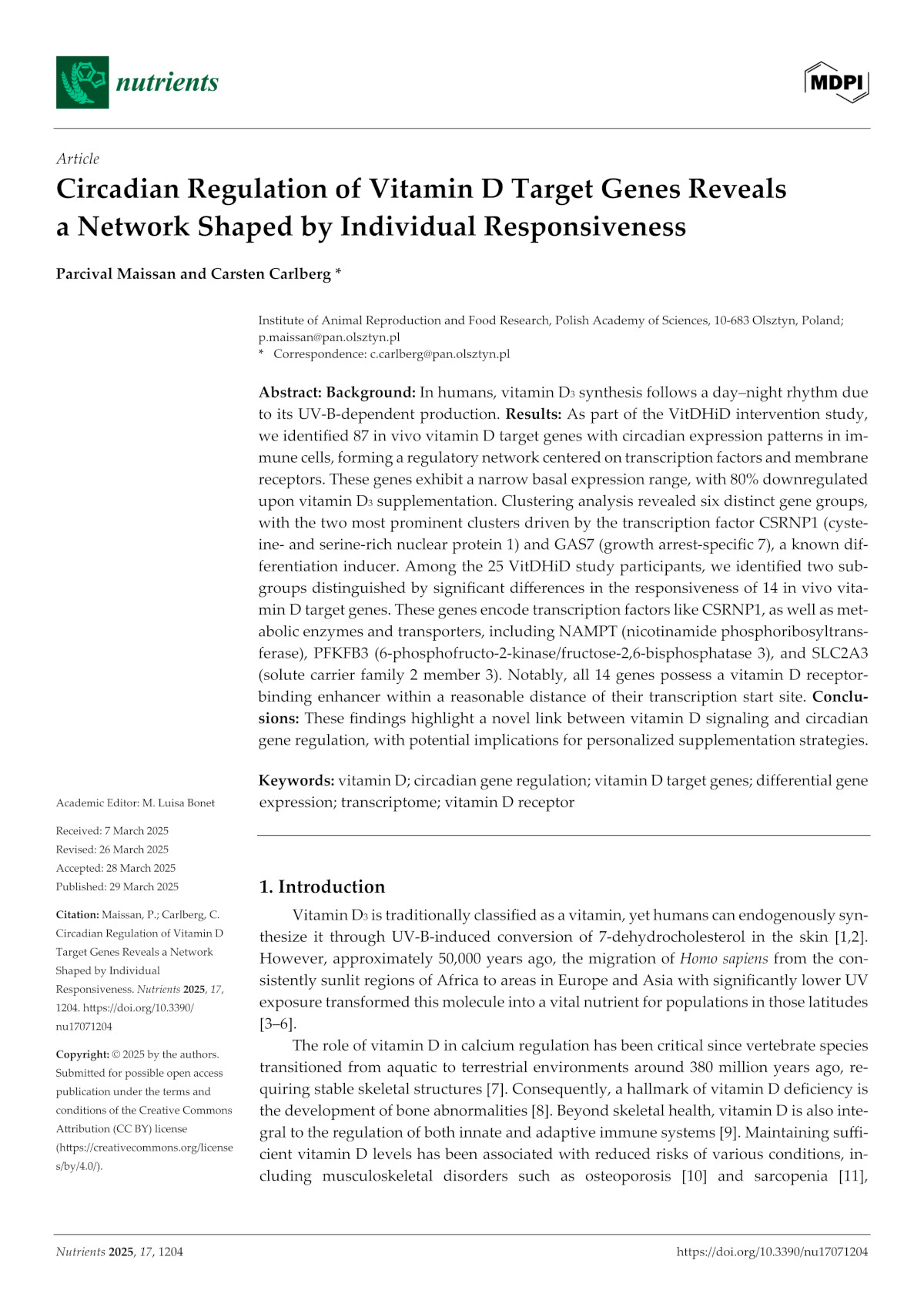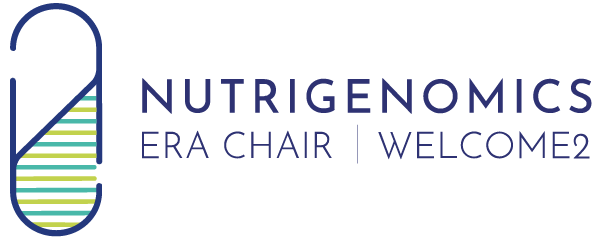Home » Publications » Page 2

Parcival Maissan, Carsten Carlberg
Circadian Regulation of Vitamin D Target Genes Reveals a Network Shaped by Individual Responsiveness
Nutrients 2025, 17(7), 1204
As part of the VitDHiD intervention study, we identified 87 in vivo vitamin D target genes with circadian expression patterns in immune cells, forming a regulatory network centered on transcription factors and membrane receptors. These genes exhibit a narrow basal expression range, with 80% downregulated upon vitamin D3 supplementation. Clustering analysis revealed six distinct gene groups, with the two most prominent clusters driven by the transcription factor CSRNP1 (cysteine- and serine-rich nuclear protein 1) and GAS7 (growth arrest-specific 7), a known differentiation inducer. Among the 25 VitDHiD study participants, we identified two subgroups distinguished by significant differences in the responsiveness of 14 in vivo vitamin D target genes. These genes encode transcription factors like CSRNP1, as well as metabolic enzymes and transporters, including NAMPT (nicotinamide phosphoribosyltransferase), PFKFB3 (6-phosphofructo-2-kinase/fructose-2,6-bisphosphatase 3), and SLC2A3 (solute carrier family 2 member 3). Notably, all 14 genes possess a vitamin D receptor-binding enhancer within a reasonable distance of their transcription start site.
Circadian Regulation of Vitamin D Target Genes Reveals a Network Shaped by Individual Responsiveness [PDF]
View full text

Marek Gowkielewicz, Aleksandra Lipka, Wojciech Zdanowski, Tomasz Waśniewski, Marta Majewska, Carsten Carlberg
Anti-Müllerian hormone: biology and role in endocrinology and cancers
Front. Endocrinol., 16 September 2024, Sec. Cancer Endocrinology, Volume 15 - 2024
Anti-Müllerian hormone (AMH) is a peptide belonging to the transforming growth factor beta superfamily and acts exclusively through its receptor type 2 (AMHR2). From the 8th week of pregnancy, AMH is produced by Sertoli cells, and from the 23rd week of gestation, it is produced by granulosa cells of the ovary. AMH plays a critical role in regulating gonadotropin secretion, ovarian tissue responsiveness to pituitary hormones, and the pathogenesis of polycystic ovarian syndrome. It inhibits the transition from primordial to primary follicles and is considered the best marker of ovarian reserve. Therefore, measuring AMH concentration of the hormone is valuable in managing assisted reproductive technologies. AMH was initially discovered through its role in the degeneration of Müllerian ducts in male fetuses. However, due to its ability to inhibit the cell cycle and induce apoptosis, it has also garnered interest in oncology. For example, antibodies targeting AMHR2 are being investigated for their potential in diagnosing and treating various cancers. Additionally, AMH is present in motor neurons and functions as a protective and growth factor. Consequently, it is involved in learning and memory processes and may support the treatment of Alzheimer’s disease. This review aims to provide a comprehensive overview of the biology of AMH and its role in both endocrinology and oncology.
View full text

Ranjini Ghosh Dastidar, Julia Jaroslawska, Marjo Malinen, Tomi‑Pekka Tuomainen, Jyrki K. Virtanen, Igor Bendik & Carsten Carlberg
In vivo vitamin D targets reveal the upregulation of focal adhesion‑related genes in primary immune cells of healthy individuals
Scientific Reports volume 14, Article number: 17552 (2024), 30 July 2024
Vitamin D modulates innate and adaptive immunity, the molecular mechanisms of which we aim to understand under human in vivo conditions. Therefore, we designed the study VitDHiD (NCT03537027) as a human investigation, in which 25 healthy individuals were supplemented with a single vitamin D3 bolus (80,000 IU). Transcriptome-wide differential gene expression analysis of peripheral blood mononuclear cells (PBMCs), which were isolated directly before and 24 h after supplementation, identified 452 genes significantly (FDR < 0.05) responding to vitamin D. In vitro studies using PBMCs from the same individuals confirmed 138 of these genes as targets of 1α,25-dihydroxyvitamin D3. A subset of the 91 most regulated in vivo vitamin D target genes indicated focal adhesion as the major pathway being upregulated by vitamin D3 supplementation of healthy individuals. Differences in the individual-specific responsiveness of in vivo vitamin D target genes in relation to the increase of the person’s vitamin D status allowed a segregation of the VitDHiD participants into 9 high, 12 mid and 4 low responders. The expression profile of nearly 600 genes elucidate the difference between high and low vitamin D responders, the most prominent of which is the HLA-C (major histocompatibility complex, class I, C) gene.
View full text

Julia Jarosławska, Ranjini Ghosh Dastidar, Carsten Carlberg
In vivo vitamin D target genes interconnect key signaling pathways of innate immunity
PLoS ONE July 2024 19(7): e0306426
The vitamin D3 metabolite 1,25-dihydroxyvitamin D3 (1,25(OH)2D3), its nuclear receptor VDR (vitamin D receptor) and hundreds of their target genes are not only key regulators of calcium homeostasis, but also important modulators of the immune system. Innate immune cells like monocytes use VDR for efficient differentiation and are very responsive to vitamin D. So far, most information on the gene regulatory function of vitamin D and its physiological impact had been obtained from in vitro studies using supraphysiological doses of 1,25(OH)2D3. Therefore, medical experiments like the study VitDHiD (NCT03537027), where 25 healthy individuals were supplemented once with a vitamin D3 bolus (80,000 IU), provide important insight into the response to vitamin D under in vivo conditions. In this study, we inspected 452 in vivo vitamin D target genes from peripheral blood mononuclear cells (PBMCs) detected in VitDHiD and found 61 of them involved in eight major KEGG (Kyoto Encyclopedia of Genes and Genomes) pathways of innate immunity. Under in vivo conditions in healthy individuals vitamin D either silences five pathways of innate immunity, stabilizes two and increases one, so that acute inflammation is suppressed and the release of cytokines is kept under control. A ranking of the 61 target genes by inducibility, basal expression and multiple involvements in the pathways highlighted the genes NFKBIA (NFκB inhibitor alpha), NFKBIZ, FOSL2 (FOS like 2, AP1 transcription factor subunit), JDP2 (Jun dimerization protein 2), PIK3R1 (phosphoinositide-3-kinase regulatory subunit 1), CLEC7A (C-type lectin domain containing 7A), DUSP6 (dual specificity phosphatase 6), NCF2 (neutrophil cytosolic factor 2), PLCB1 (phospholipase C beta 1), PLCG2 and TNFAIP3 (TNF alpha induced protein 3). In conclusion, vitamin D’s in vivo effect on innate immunity in healthy adults is mediated by the interconnection of the pathways of neutrophil extracellular trap formation, Toll-like receptor, chemokine and phagosome signaling, NOD-like receptor, C-type lectin receptor, apoptosis and interleukin 17 through a limited set of proteins encoded by key target genes.
View full text







